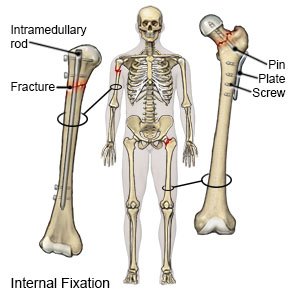ORIF of a Wrist Fracture in Children
Medically reviewed by Drugs.com. Last updated on Apr 6, 2025.
What do I need to know about open reduction and internal fixation (ORIF) of a wrist fracture?
ORIF of a wrist fracture is surgery to fix a broken wrist. Open reduction means that the bone is moved back into the right place with surgery. Internal fixation means that hardware (such as screws, rods, or pins) is used to hold the broken bones together.
 |
How do I prepare my child for ORIF?
- Your child's surgeon will tell you how to prepare him or her for surgery. He or she may tell you not to let your child eat or drink anything after midnight before surgery.
- Tell your child's surgeon about all medicines he or she currently takes. The surgeon will tell you if your child needs to stop any medicine for surgery, and when to stop. He or she will tell you which medicines your child should take or not take on the day of surgery.
- Tell your child's surgeon about all his or her allergies. Tell the surgeon if your child had an allergic reaction to anesthesia or antibiotics.
What will happen during ORIF?
- Your child may be given general anesthesia to keep him or her asleep and free from pain during surgery. He or she may instead be given local anesthesia to numb the area. Your child will be awake for surgery if he or she gets local anesthesia, but he or she should not feel pain. Your child's surgeon will make one or more incisions on your child's wrist. The broken bones will be put back into the correct position. Medical plates, screws, pins, or wires will be used to hold the broken bones together. A bone graft may be placed in or around the fracture to strengthen the wrist.
- X-rays may be taken during surgery to make sure the broken bone is set properly. X-rays also show if the pins, plates, and screws are placed correctly. Your child's surgeon will close the incision with stitches or staples. A splint will be placed over your child's wrist to prevent movement while it heals.
What should my child expect after ORIF?
Your child will be taken to a room to rest until he or she is fully awake. Healthcare providers will monitor your child closely for any problems. Do not let your child get out of bed until a healthcare provider says it is okay. When a healthcare provider sees that your child is okay, he or she may be able to go home. Medicine may be given to relieve or prevent pain or nausea.
What are the risks of ORIF for a wrist fracture?
Your child's tendons and nerves may get injured during or after surgery. The wrist may not heal properly. Your child may continue to have wrist pain. He or she may develop a life-threatening blood clot.
Care Agreement
You have the right to help plan your child's care. Learn about your child's health condition and how it may be treated. Discuss treatment options with your child's healthcare providers to decide what care you want for your child. The above information is an educational aid only. It is not intended as medical advice for individual conditions or treatments. Talk to your doctor, nurse or pharmacist before following any medical regimen to see if it is safe and effective for you.© Copyright Merative 2025 Information is for End User's use only and may not be sold, redistributed or otherwise used for commercial purposes.
Further information
Always consult your healthcare provider to ensure the information displayed on this page applies to your personal circumstances.
